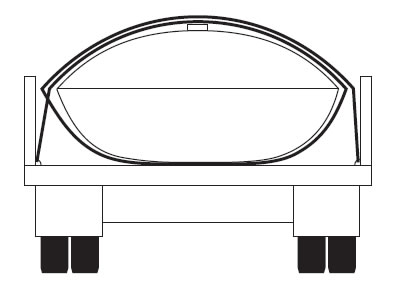These guidelines apply to the transportation of fluid carrying tanks of the nonrigid type and are based on overseas tests and regulations as well as New Zealand tests. When empty these tanks are usually rolled up so that the deck of the vehicle can be used for other loads. Consultation with the statutory authorities is required if hazardous liquids are proposed to be carried in flexible tanks. Higher safety standards will be required.
Whereas most loads rely on partial rigidity of the load to prevent forward and sideways movement, this is not the case with these flexible tanks where all forward and sideways movement must be restrained by the lashings alone.
Note: Lashings refers to rope, chain synthetic webbing straps, etc. The lashings must therefore be of extra high standard.
The tanks are usually made of a fabric reinforced rubber and should have sufficient strength in fabric and seam joints to withstand dynamic surge loads up to 1 ‘g’. Reduction of surge can be achieved by ensuring that the tank is filled to the capacity as specified by the manufacturer. Any air is dispelled and the tank is tightly secured to the vehicle.
There are two methods by which the tanks can be transported – within a container, or on the flat deck of a truck or trailer.
The container is to be designed to the standard specified by the International Organization for Standardisation (test recommendation R1496). This is the standard to which general ISO freight containers are designed.
Anchorage rings designed for a safe working load of 5000kg are to be installed within the container to the base frame at intervals of not greater than 1.5 metres along each side (refer to British Hovercraft Corporation specification BH/FT/FI/246 or BH/FT/FI330 for details of anchorage rings). The lashing must be synthetic webbing strap with a rated strength of at least 2000kg.
The width of the flexible tank when full and secured to the deck is not to exceed 2.5 metres.
The number of lashings to be applied is as follows:
Weight of tank plus max load kg |
Minimum number of lashing |
| 0–1999 | 3 |
| 2000–3999 | 4 |
| 4000–5999 | 5 |
| 6000–7999 | 6 |
| 8000–9999 | 7 |
| 10,000–11,999 | 8 |
| 12,000–13,999 | 9 |
| 14,000–15,999 | 10 |
| 16,000–17,999 | 11 |
| 18,000–19,999 | 12 |
The lashing is to consist of synthetic webbing strap with a rated strength of not less than 2000kg. Chain is not recommended because of abrasion problems. However, if used, a protective covering between the flexible tank and chain must be used.
There are two systems of arranging the lashings:
When these are used they should run from the anchor point at one side of the vehicle over and in a full circle around the tank, then down to an anchor point on the other side of the vehicle (refer figure 77). Because the liquid is inclined to affect the shape of the tank during deceleration, the lashings should be distributed somewhat more closely at the forward part of the tank (refer figure 78).
Where a stitched net of synthetic fibre webbing is used, ropes or webbing straps may be used to complete the system of securing to the vehicle (refer figure 79). Chains may be used. However, if they come into contact with the surface of the flexible tank a protective covering must be used.
Any ropes used in webbing arrangements must be of good quality and at least 16mm diameter.
Any chains used must be at least:
OR
Any strainers, hooks or other fittings used in connection with lashings must be strong and fastened so that they will withstand a force of at least the same magnitude as the part of the lashing to which they are joined.
 Figure 77
Figure 77 
Figure 78
 Figure 79
Figure 79A headboard must be fitted to the truck and any trailer used for the carriage of flexible tanks.
Any side boards and tail boards fitted must reach at least 100mm above the highest point of the maximum width of the tank. In this case anchor points will have to be fitted on the deck of the vehicle within the side and tail boards (refer figure 80).
Two smaller tanks should be carried in preference to one large tank to further decrease surging. A chain may then be securely fastened between the tanks to the deck of the vehicle so that any longitudinal lashings may be secured to this chain (refer figure 79).
If the securing system is to retain the tank in an emergency situation, the hooks or tie-rails on the vehicle must be of a high standard. It must be realised that the combined weight on the hooks or tie-rail can be equivalent to half the total weight of the load in such a situation.
 Figure 80
Figure 80